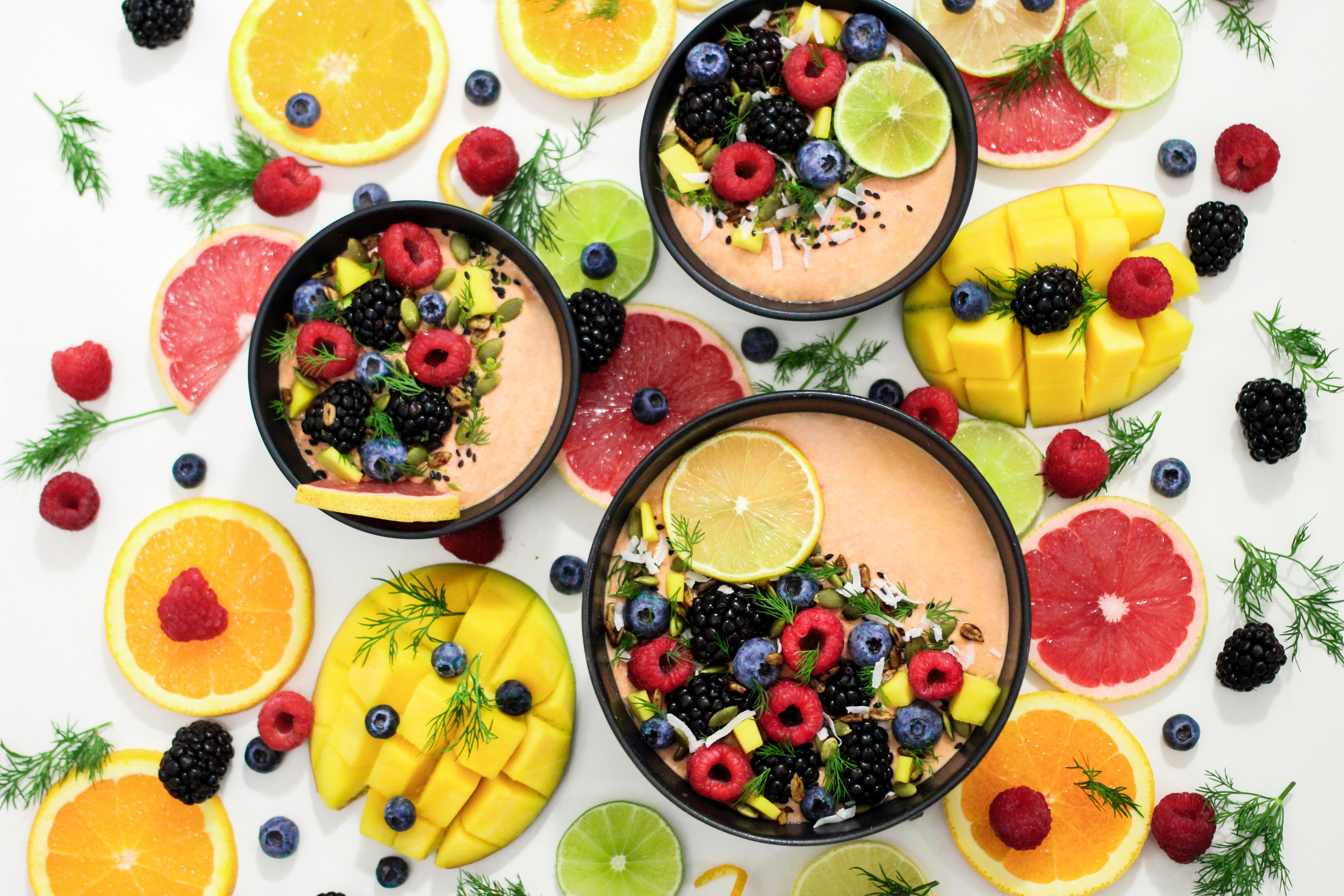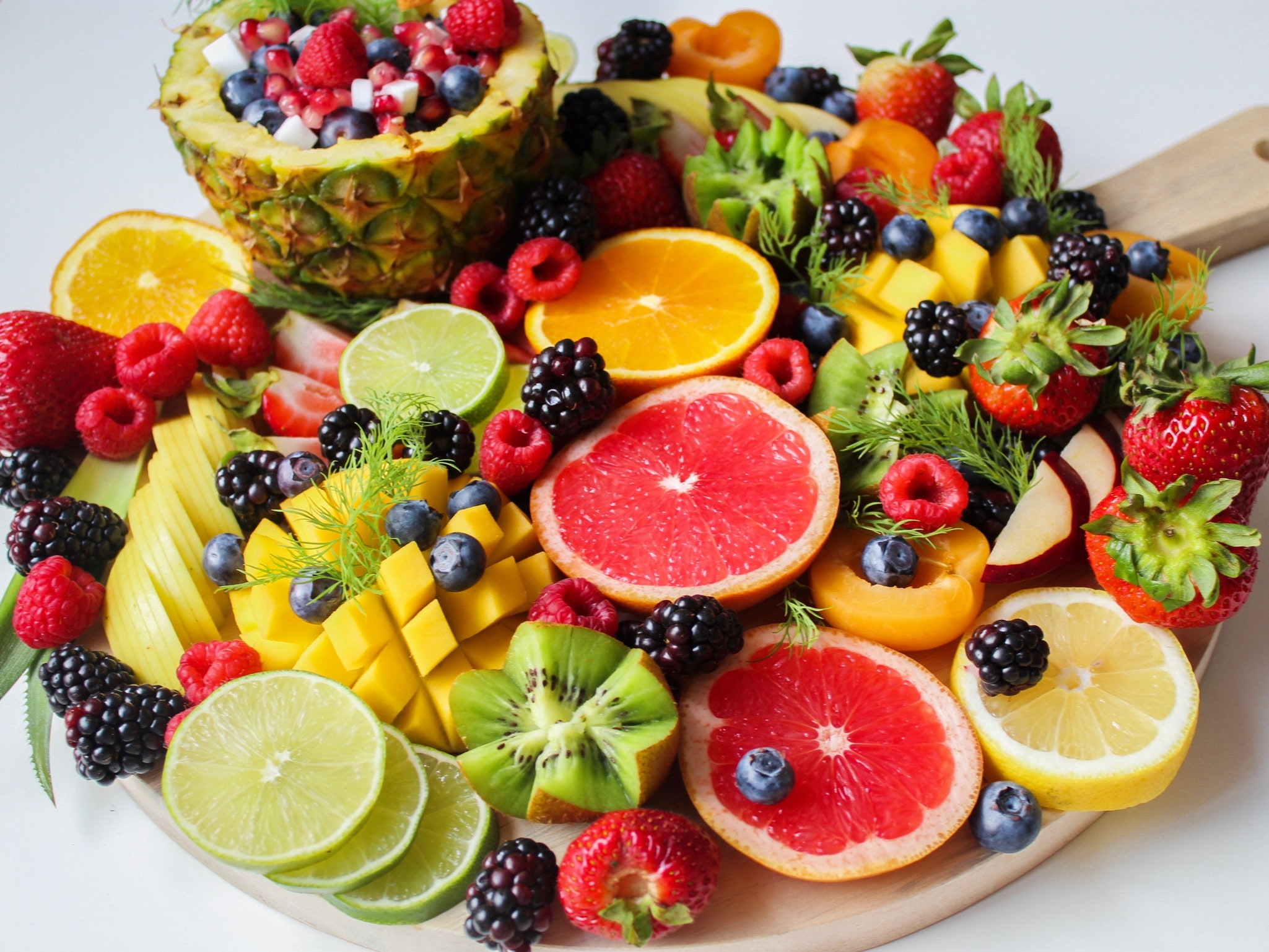“As a group, tropical fruits are full of nutrients that may help control blood pressure, keep digestion running smoothly, and maybe even lower the risk of cancer and heart disease,” Here, we will guide you about the nutrition and benefits of top tropical fruits to help you eat healthily and stay fit.
What are Tropical Fruits?
Tropical fruits are very well-known all over the world. Some notable examples are pomegranates, mangoes, papayas, avocados, bananas, pineapples, guavas, star-fruits, kiwis, dates, and passion fruits. The banana is one of the most popular fruits around the world, and this is because it is easy to grow, pick, and ship.
Thanks to a steady supply of fruit from the tropics, many fruits are always available in big markets. Other tropical fruit cultivars are more obscure. Even though they may be prevalent in some parts of the world, most people have never heard of them, and some take time to get used to.
Soursops, cherimoyas, sugar apples, jackfruit, pawpaws, durian, acerolas, mamey, akee, breadfruit, lychees, rambutans, and mangosteens are some of the more unusual types of tropical fruit. Some of these fruits, like jackfruit and durian, are known for their strong smell and taste. Others, like mangosteens, lychees, and cherimoyas, are delicious but hard to grow, making promoting them hard.
Reference: Antioxidant properties of several tropical fruits:
Top Five Tropical Fruits
If you’ve ever passed by the tropical fruit stand because you weren’t sure how to buy or prepare those fascinating wonders, learn plenty of tips on selecting, cutting, designing, and even cooking with various Thai fruits.
1. Papayas
Christopher Columbus called papaya the “fruit of the angels,” and he was right. Papaya is sweet, juicy, and good for your health. This is one of the healthiest fruits because it contains antioxidants, flavonoids, and many vitamins and minerals. Find out how to pick ripe papaya and cut, prepare, and cook with this most delicious fruit.
Papaya comes from South America and Mexico. It is also grown in many tropical places, like Hawaii, where it is a common crop. When the fruit’s skin is yellow-green, it is ready to be picked. As the fruit ripens, the skin turns yellow. Most of the time, the flesh inside is orange, but some are pink or red.
Papaya is also known as pawpaw, mama, and tree melon. You can eat the black seeds, but not the skin. Even though the fruit can weigh up to 20 pounds, the average papaya in the market is about 6 inches long, has a pear shape, and weighs no more than 2 pounds.
Green papaya is a fruit that isn’t fully ripe yet, and its seeds are usually white and more like a vegetable than a fruit. To get to the flesh and seeds inside papaya, you must cut it open. It is one of the more expensive fruits on markets and can be eaten raw or cooked. Green papaya is often used in Asian cooking and needs to be cooked before it can be eaten.
2. Lychee Fruit
Lychee is a tasty tropical fruit that can be eaten at any time of the year. It is a fruit from China and is sometimes spelled litchi or called alligator strawberry. It can grow in some parts of the United States. Usually, you can buy fresh lychee at an Asian market.
Under the hard, bumpy husk is soft, white flesh that tastes like a mix of strawberry and watermelon. This flesh covers the fruit’s seed, a hard stone you can’t eat. Lychee can be eaten raw on its own and also goes well in fruit salads, sauces, desserts, and drinks. Before eating or cooking with lychee, you’ll need to know how to choose and peel this small, delicate fruit.
3. Pineapple
Fresh pineapple is a juicy snack that is full of vitamin C. It also helps digestion because it has an enzyme called bromelain that breaks down protein. In Asia, pineapple can be eaten fresh, but it is also used in savory salads (called “rojak”), added to peanut sauce for satay, or dipped in dark soy sauce, sugar, and chili.
4. Star Fruit
Starfruit is a juicy tropical fruit that grows in Thailand, Southeast Asia, Australia, and South America. They are also grown in Hawaii and Florida, making them easy to find at your local grocery store or market. Starfruit is a good choice during the winter when they are easy to find.
Star fruit is an excellent choice for people trying to lose weight because each fruit has only 30 calories and a lot of fibre. They are also very healthy because they are full of flavonoids and antioxidants. And because they have a lot of vitamin C, star fruit can help strengthen your immune system, which is great for avoiding colds and flu in the winter.
5. Dragon Fruit
Dragon fruit is a beautiful fruit grown in Southeast Asia, Mexico, Central, and South America, Israel, and other places. It is also called pitaya or pitahaya. Please find out more about this strange-looking fruit, such as how to prepare, eat, and use it in cooking.
Also, find out what dragon fruit is good for you, and then go out and get one of nature’s most beautiful and delicious fruits. Dragon fruit is a lovely tropical fruit called pitaya or strawberry pear. It is sweet and crunchy. The fruit comes from a type of cactus called Hylocereus, of which there are about 20 different species.
Dragon fruit was prevalent in Southeast Asia and Latin America, but now it is grown and eaten everywhere. Even though it looks scary with its pinkish-red skin and light green scales, this strange fruit is easy to prepare. You can eat it in fruit salads, make tasty drinks and desserts, or eat it as a healthy snack.
Benefits of Tropical Fruits
- Tropical fruits have enzymes that help break down proteins. These enzymes, called bromelain, reduce inflammation and help your body digest food better.
- Tropical fruits contain a lot of vitamin B6 and potassium, which help control your blood pressure.
- Breast cancer risk goes down when you eat tropical fruits. Studies have shown that eating one or more tropical fruits daily may lower the chance of breast cancer.
- Antioxidants are found in a lot of tropical fruits. They have more antioxidants than dark chocolate and work like a solid wall to protect your heart from diseases.
- Tropical fruits lower the chance of getting diseases that affect the kidneys.
Is Mango a Tropical Fruit that Offers Hidden Health Benefits?
Mangoes are full of good things for you. It is an excellent source of vitamin C, with one cup giving you nearly 75% of the daily value. With all the vitamins they have, mangoes have a lot of benefits for the immune system, like lowering the risk of getting sick and making more white blood cells.
It Could Help Prevent Diabetes- Even though mango has a lot of natural sugar, it can help keep diabetes from starting. It might even help people with diabetes control their blood sugar. Still, like anything else, it’s best to eat this fruit in small amounts.
It Increases Digestive Health- If you have digestive problems, eating mango could help by stopping diarrhea or constipation, and this is because mango is high in dietary fiber and water.
It Is Rich in Antioxidants- The antioxidants in mango, like the “super antioxidant” mangiferin, protect your cells from damage caused by free radicals. Free radicals can hurt cells, leading to many types of long-term diseases.
It Promotes Heart Health- Mango has a lot of magnesium and potassium, improving blood flow by relaxing blood vessels. This mix can help bring down high blood pressure.
How to Select Fresh Lychee?
Most of the time, lychee is in season from the end of spring to the beginning of fall. After being picked from the tree, lychee fruit doesn’t get any riper. It also starts to ferment, so you should only use the freshest fruit and plan to use it within a week.
Whether you buy lychee at a market or pick it from a tree, look for fruit with a skin that is more than an inch in diameter and brightly colored. The skin of most lychees is red, but some are orange or yellow with a hint of pink.
To see if it’s ready, gently press your thumb on the skin. It should have some give, and it may be too ripe if it’s too soft. When lychee is ready, it will smell like a lush garden. If lychee has gone wrong, it will have a brown husk or a cracked fruit that leaks liquid or smells fermented.
Is Kiwi a Tropical Fruit that you can Grow at Home?
How would you like to grow tropical fruit at home? If you don’t live in the tropics, you might not think it’s possible, but it is! Even though it can be hard to grow a plant that will produce fruit you can eat, it is possible with some care, time, and patience.
You’ll at least get a pretty kiwi plant as a reward. There are different kinds of kiwis. The most common type is the one you can find in grocery stores. It has thick, fuzzy skin. You’ll find a green pulp with seeds if you cut it open. It’s easy to start growing because the sources are easy to take.
1. Harvest the Seeds
First, cut your kiwi in half and then remove the seeds with a spoon. Put the roots in a small bowl, rinse them with water, and then strain the water off the bases.
2. Germinate the Seeds
Next, it’s time to germinate the seeds. The best method is to spread the bases on a damp paper towel and put them in a resealable plastic sandwich bag. Seal the bag and then put it in a warm location. Check them daily for signs of sprouting. Also, make sure the paper towel stays damp. If it gets dry, it’s helpful to spray it with water from a spray bottle.
3. Pot the Seedlings
Soon, your seedlings will start to grow. Now is the time to put them in their pots, but you first need to get the jars ready. Put potting mix for starting seeds in a few small pots and wet the soil. The seedlings will stick to the paper towel. Tear the paper towel into pieces holding three or four seedlings each, then plant each piece in its pot.
4. Provide Significant Sunlight
Your little seedlings in pots will need a place to get a lot of light. Put the banks where they should be and watch the plants grow. Most of the time, it’s best to keep your plants inside for the first few years to protect them from harsh weather.
5. Transfer the Plants
As your plants grow, you will need to move them to bigger pots every so often. Start feeding them with a starter fertilizer when you move them for the first time.
Conclusion
“Avocados are rich in monounsaturated fats. These healthy fats can help lower levels of ‘bad’ blood cholesterol, or LDL, and can also help lower the risk of heart disease and stroke,” We hope this guide will help you choose the best tropical fruits to consume and be healthy. “These fruits are often high in vitamin C, potassium, beta-carotene, fibre, and even healthy fats if you count avocados as fruits, which they are.”

